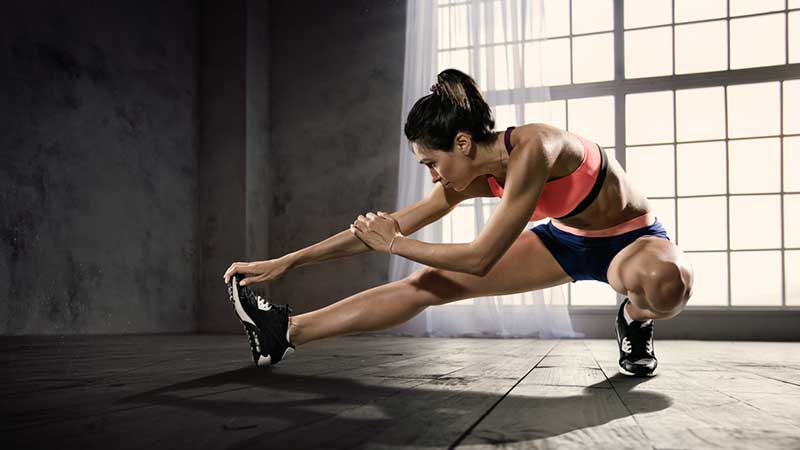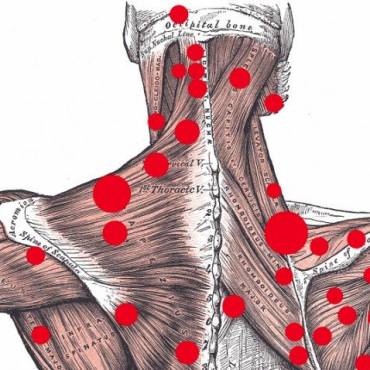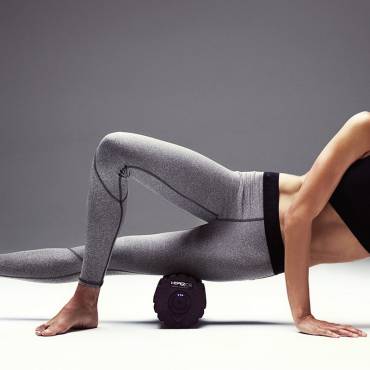Active Stretching
Stretching: Micro-Entry
Overview
There are 3 different popular stretching protocols employed regularly today: static stretching, dynamic stretching, and proprioceptive neuromuscular facilitation (PNF) stretching. Static stretching involves lengthening a muscle and holding it in a mildly uncomfortable position for a period, usually somewhere between 10 and 30 s. Dynamic stretching uses momentum and active muscular effort to lengthen a muscle, but the end position is not held. PNF stretching typically involves a contraction of the opposing muscle to stretch the target muscle, followed by an isometric contraction of the target muscle.
Static stretching is an effective way to increase flexibility, although it may not be superior to full range-of-motion eccentric weight training. Static stretching may acutely increase range of motion by affecting the structural properties of the muscle and tendon, as well as the nervous system resulting in increased stretch tolerance. It may also serve to effectively reduce blood pressure following a resistance training session.
Five to ten minutes per week per muscle group, split up over 5 sessions, is potentially an optimal prescription of static stretching to increase range of motion. Therefore it is likely that static stretching is highly over-prescribed as part of general fitness programs.
It may be prudent to substitute dynamic stretching in place of static stretching directly preceding exercise to prevent potential acute explosive power decrements that have been observed with static stretching, although this may be unnecessary for strength based movements. Since there is equivocal evidence for the effect in strength training, a good recommendation at present for all activities would be to warm-up dynamically and save static stretching for post-exercise.
Stretching before or after exercising does not confer protection from muscle soreness. Stretching before exercising does not seem to confer a practically useful reduction in the risk of injury, but the generality of this finding needs testing. The practice of stretching peri-workout to aid in muscle hypertrophy has equivocal support in the literature, but may be most relevant when the stretch is utilized under load at the end range of motion, in untrained individuals in particular. And being flexible does not appear to show significant connection to mortality, improved quality of life, pain, or performance.
Research
Static stretching for 5-10 min/week appears optimal for increasing range of motion in a particular muscle group, with no further increase in mobility found in sessions longer than 10 min/week. Time spent stretching within a single session does not seem to have significant effects for ROM gains, but weekly frequency is positively associated to ROM. These 5-10 minutes per muscle group per week are likely best spread over 5 sessions to maximize return.
DOI: 10.1055/s-0044-101146
Participants felt they were more likely to perform well when stretching was performed as part of the warm-up, irrespective of stretch type. However, no effect of muscle stretching was observed on flexibility and physical function compared with no stretching. On the basis of the current evidence, the inclusion of short durations of either static or dynamic stretching is unlikely to affect sprint running, jumping, or change of direction performance when performed as part of a comprehensive physical preparation routine. i.e. power decrements from static stretching do not appear to be problematic when incorporated into a comprehensive routine that contains other dynamic movements.
doi: 10.1249/MSS.0000000000001539
Stretching the hamstrings immediately before each set of the back squat can be used to acutely increase biceps femoris thickness without impairing squat performance. Strength performance was unaffected.
https://doi.org/10.3389/fphys.2020.00769
Prolonged static stretching causes acute, non-metabolic fatigue and impairs exercise tolerance during severe intensity cycling. These results suggest a link between exercise intolerance and the decreased ability to produce force.
https://doi.org/10.1139/apnm-2019-0981
There is nothing necessarily wrong with static stretching, although it appears to be given a much higher priority than the return is worth. “The current paper proposes flexibility be retired as a major component of physical fitness, and consequently, stretching be de-emphasized as a standard component of exercise prescriptions for most populations. First, I show flexibility has little predictive or concurrent validity with health and performance outcomes (e.g., mortality, falls, occupational performance) in apparently healthy individuals, particularly when viewed in light of the other major components of fitness (i.e., body composition, cardiovascular endurance, muscle endurance, muscle strength). Second, I explain that if flexibility requires improvement, this does not necessitate a prescription of stretching in most populations. Flexibility can be maintained or improved by exercise modalities that cause more robust health benefits than stretching (e.g., resistance training). Retirement of flexibility as a major component of physical fitness will simplify fitness batteries; save time and resources dedicated to flexibility instruction, measurement, and evaluation; and prevent erroneous conclusions about fitness status when interpreting flexibility scores.” Being flexible shows no connection to mortality, improved quality of life, pain, or performance. De-emphasis of stretching in exercise prescriptions will ensure stretching does not negatively impact other exercise and does not take away from time that could be allocated to training activities that have more robust health and performance benefits.
DOI: 10.1007/s40279-019-01248-w
20s short static stretching increases ROM and does not decrease maximum torque when done 5-10 minutes before a workout.
DOI: 10.1371/journal.pone.0228583
In conclusion, passive, low‐intensity stretch does not appear to confer beneficial changes in muscle size and architecture (hypertrophy); alternatively, albeit limited evidence suggests that when stretching is done with a certain degree of tensile strain (particularly when loaded, or added between active muscle contractions) may elicit muscle hypertrophy. This suggests that loading at the end ranges of motion may confer some hypertrophic benefit.
https://doi.org/10.1111/cpf.12622
Static stretching is likely less about making structural changes, and more about improving one’s tolerance to discomfort. Increased range of motion after static stretching is not likely due to changes in muscle and tendon structures. “The increased range of motion could not be explained by the structural changes in the muscle-tendon unit, and was likely due to increased stretch tolerance possibly due to adaptations of nociceptive nerve endings.”
https://doi.org/10.1016/j.clinbiomech.2014.04.013
This systemic review suggests full range-of-motion training is as effective as static stretching regimens with regards to increasing flexibility. “The results support the hypothesis that eccentric training is an effective method of increasing lower limb flexibility.”
https://www.ncbi.nlm.nih.gov/pubmed/22522590
“80 seconds of static stretching and dynamic stretching did not induce any additional muscular adaptations to resistance training in untrained young men.”
https://journals.lww.com/nsca-jscr/Abstract/publishahead/Effects_of_Static_and_Dynamic_Stretching_Performed.94656.aspx
“Performing static stretching exercises after the RT session provide an ideal combination for a postexercise hypotensive response from 30 minutes after exercise (and this change was enhanced up to 60 minutes)…In conclusion, strength and conditioning professionals can prescribe static stretching exercises after RT if the goal is to reduce blood pressure after training.”
https://journals.lww.com/nsca-jscr/Citation/2019/11000/Static_Stretch_Performed_After_Strength_Training.13.aspx
“A total of 26 studies were selected, with a duration ranging from 3 to 8 weeks, and an average total time under stretching of 1165 seconds per week. Small effects were seen for maximal tolerated passive torque, but trivial effects were seen for joint resistance to stretch, muscle architecture, muscle stiffness, and tendon stiffness. A large heterogeneity was seen for most of the variables. Stretching interventions with 3- to 8-week duration do not seem to change either the muscle or the tendon properties, although it increases the extensibility and tolerance to a greater tensile force. Adaptations to chronic stretching protocols shorter than 8 weeks seem to mostly occur at a sensory level.”
https://www.ncbi.nlm.nih.gov/pubmed/28801950
“Previous studies have reported no changes on muscle architecture (MA) after static stretching interventions; however, authors have argued that stretching duration and intensity may not have been sufficient. A high-intensity stretching intervention targeting the knee flexors with an 8-week duration was conducted to observe the effects on biceps femoris long head (BF) architecture. Participants (n = 5) performed an average of 3.1 assisted-stretching sessions per week, whereas a control group (n = 5) did not perform stretching. The knee extension passive maximal range of motion (ROM), and BF fascicle length (FL), fascicle angle, and muscle thickness were assessed before and after the intervention. A significant increase was observed for FL (+12.3 mm, p = 0.04) and maximal ROM (+14.2°, p = 0.04) for the stretching group after the intervention. No significant changes were observed for the control group in any parameter. An 8-week high-intensity stretching program was observed to efficiently increase the BF FL, as well as the knee extension maximal ROM. Stretching intensity and duration may play an important role on MA adaptation.”
https://www.ncbi.nlm.nih.gov/pubmed/25486299
“These results show that performing flexibility training immediately before resistance training can contribute to a lower number of repetitions, total volume, and muscle hypertrophy.”
https://www.ncbi.nlm.nih.gov/pubmed/28251401
“Although static stretching enhances flexibility, which is a well-recognized component of health-related fitness (1), there is little scientific evidence to suggest that pre-event static stretching prevents activity-related injury or enhances athletic performance (32, 47, 50, 53). Even athletes who compete in sports that require high levels of flexibility, such as gymnastics or diving, must consider both the potential benefits and the related concerns when deciding whether or not to include static stretching exercises in the warm-up routine.
A growing body of research evidence indicates that pre-event static stretching of the prime movers may actually have a negative effect on force production, power performance, strength endurance, reaction time, and running speed (4, 10, 11, 19, 34, 40, 41). In one research study that examined the effects of static stretching on sprint performance in collegiate track-and-field athletes, researchers reported a 3% decrease in sprinting performance at 40 m following pre-event static stretching (57). It has also been shown that pre-event ballistic stretching (i.e., bouncing movements) and stretching techniques for proprioceptive neuromuscular facilitation (PNF), which involve both passive movements and active muscle actions, can also inhibit strength and reduce explosive power (6, 39). Although some data suggest that pre-event static stretching has no short-term effect on performance measures (23, 33), a majority of the available evidence indicates that it can have detrimental effects on subsequent performance.
This stretching-induced effect is thought to be related to a decrease in neural activation, reduced musculotendinous stiffness, or a combination of neural and muscular factors (3, 20, 24). Since static stretching can result in muscle damage (as evidenced by elevated levels of creatine kinase in the blood), it is also possible that tissue damage could explain, at least in part, stretching-induced decrements in performance (51). While the undesirable effects of an acute bout of static stretching on performance are increasingly apparent, additional research is needed to determine the precise mechanisms underlying the performance decrements, as well as the particular stretching protocols and performance conditions that produce this adverse effect.
Of note, the observed reductions in performance following static stretching may, in some cases, last up to one hour (20). Since even a 1% change in performance can have a noticeable influence on the outcome of an athletic event in both individual and team sports, the small but significant changes in performance following an acute bout of static stretching should be considered by sport coaches and strength and conditioning professionals. Indeed, several fitness and medical organizations, including the American College of Sports Medicine (1), the National Strength and Conditioning Association (28), and the President’s Council on Physical Fitness and Sports (32) contend that pre-event static stretching may adversely affect athletic performance, particularly in sports that involve strength and power.
This is not to say that static stretching should be eliminated from an athlete’s program, but it should be sensibly incorporated into the daily training regimen, since chronic stretching can enhance the range of motion around a joint and potentially improve strength and power performance (35, 52). Consequently, most athletes should perform static stretching during the cool-down or as part of a separate training session. In some cases, however, athletes who participate in sports that require high levels of flexibility may benefit from pre-event static stretching. For example, gymnasts who need to improve flexibility may perform pre-event stretching exercises after a general warm-up, provided that they perform a series of dynamic movements prior to training or competition.”
Hoffman, Jay. NSCA’s Guide to Program Design. Champaign: Human Kinetics, 2012. Print.
“In summary, dynamic stretching generally can be recommended in the period immediately prior to activity for most athletes, and static stretching and PNF stretching probably are reserved best for the period after activity, if used. If static stretching or PNF are used prior to activity, they probably should be followed by an intervening sufficient period (e.g., 5 min), dynamic stretching session, or general warm-up prior to the activity to dissipate any potential negative effects on performance.“
doi: 10.1249/JSR.0000000000000052
“In conclusion, the deficit of maximum isometric plantar flexion strength after static 5-minute stretching by holding the ankle joint at maximal dorsiflexion is restored within 10 minutes. This finding suggests that the defects of static stretching will be disabled in a short time after static stretching, although static stretching decreases maximum isometric strength immediately after stretching. In addition, taken together with our previous study findings, the mechanical property of the MTU may be a major contributor to the stretching-induced force deficit.”
https://journals.lww.com/nsca-jscr/Fulltext/2014/01000/Stretching_Induced_Deficit_of_Maximal_Isometric.19.aspx
“In conclusion, according to the results of this study, the introduction of dynamic stretching (DS) protocol 24 hours before short sprint and horizontal jumps was advantageous; however, static stretching (SS) exercise should be avoided 24 hours before explosive performances despite the absence of effects on repeated sprint ability (RSA) regardless of the types of stretching performed.”
doi: 10.1519/JSC.0b013e3182964836
“To increase ROM, all types of stretching are effective, although PNF-type stretching may be more effective for immediate gains. To avoid decrease in strength and performance that may occur in athletes due to static stretching before competition or activity, dynamic stretching is recommended for warm-up. Older adults over 65 years old should incorporate static stretching into an exercise regimen.”
https://www.ncbi.nlm.nih.gov/pmc/articles/PMC3273886/ , PMID: 22319684
“explosive muscle activities of a very short duration seem to be less affected by static muscle stretching, when compared with activities using the maximum muscle strength.”
doi: 10.1519/JSC.0b013e31823b0546
“The findings of this study suggest that intensive stretching such as lower-body [static stretching] should be avoided before training the lower body or performing the 1RM in the squat exercise in favor of a dynamic warm-up using resistance training equipment in the lower-body musculature.”
doi: 10.1519/JSC.0b013e318260b7ce
“The evidence from randomised studies suggests that muscle stretching, whether conducted before, after, or before and after exercise, does not produce clinically important reductions in delayed-onset muscle soreness in healthy adults.”
DOI: 10.1002/14651858.CD004577.pub3
“These results indicate that a greater ability to produce torque without prior stretching is related to the musculotendinous stiffness of the muscle rather than the number of motor units activated. This suggests that performing activities that reduce muscle stiffness (such as stretching), may be detrimental to performance.”
DOI: 10.1519/1533-4287(2003)017<0484:eossot>2.0.co;2
There is no strong evidence proving that flexibility or stretching is associated with rates of strains, sprains or overuse injuries that can be applied across all sports or levels of competition.”Typically, specific flexibility patterns are associated with specific sports and even positions within sports. The relationship of flexibility to athletic performance is likely to be sport-dependent. Decreased flexibility has been associated with increased in-line running and walking economy. Increased stiffness may be associated with increased isometric and concentric force generation, and muscle energy storage may be best manifested by closely matching muscle stiffness to the frequency of movement in stretch-shorten type contractions.”
DOI: 10.2165/00007256-199724050-00001
Stretching immediately before exercise does not prevent overuse or acute injuries.
https://www.ncbi.nlm.nih.gov/pubmed/20086656
“Stretching before or after exercising does not confer protection from muscle soreness. Stretching before exercising does not seem to confer a practically useful reduction in the risk of injury, but the generality of this finding needs testing.”
https://www.ncbi.nlm.nih.gov/pubmed/12202327
The results of this review do not support the role of pre-exercise or post-exercise stretching as an intervention addressing post-exercise muscle soreness. In addition, the evidence presented in this review does not support the role of pre-exercise stretching in the reduction of lower-extremity injury risk.
https://www.ncbi.nlm.nih.gov/pmc/articles/PMC1250267/
“The data on stretching and muscle soreness indicate that, on average, individuals will observe a reduction in soreness of less than 2 mm on a 100-mm scale during the 72 hours after exercise. With respect to risk of injury, the combined risk reduction of 5% indicates that the stretching protocols used in these studies do not meaningfully reduce lower extremity injury risk of army recruits undergoing military training.”
https://www.ncbi.nlm.nih.gov/pmc/articles/PMC1250267/
“With respect to the effect of pre‐participation stretching on injury prevention a limited number of studies of varying quality have shown mixed results. A general consensus is that stretching in addition to warm‐up does not affect the incidence of overuse injuries.”
https://onlinelibrary.wiley.com/doi/full/10.1111/j.1600-0838.2009.01058.x







